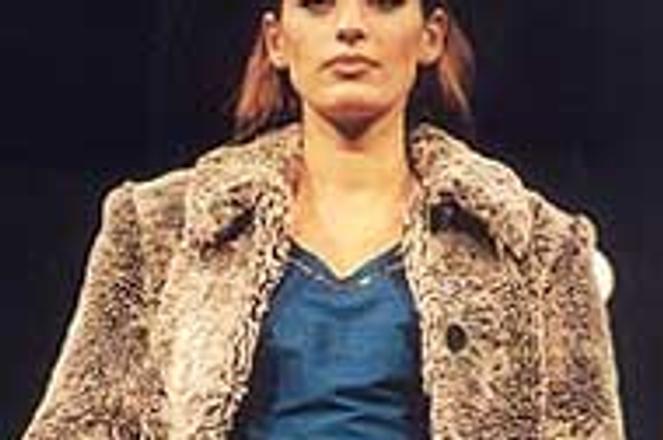Zuzana Kanisová's brand, called "Díp," is inspired by Indian design.photo:Patrik Safko
Way back before the Revolution, fashion-conscious young women couldn't find a simple, straight-cut skirt in all of Slovakia. If they didn't want something more suitable for their mother, they had to spend months looking for fabrics, queuing at shops, and sitting with personal tailors in the evening. The truly ambitious learned how to sew themselves.
Though years have passed, many of these practices have not changed. The off-the-rack clothing selection is perhaps wider, but it is of doubtful quality. Many international brands are too expensive to succeed and sometimes it seems the words chic and classy have been forgotten. Street fashion, many Slovak fashion designers say, is marred by bad colour combinations and transparent ladies' blouses. While some people dress well, those who try to look different are often labelled "weird, intellectual, or proud".
The majority of clothing in Bratislava's shops is designed neither for "the individual nor the middle class," designers say. "The situation of Slovak fashion is terrible," said Mária Miklošková, the fashion editor to Slovakia's Eva fashion magazine. "The young people go shopping in Vienna, as it is close and sometimes cheaper."
Though the number of Slovak fashion designers is on the rise, particular challenges await them. For one, designers say finding a Slovak "fashion target group" is somewhat of a paradox. In more traditional Slovak circles, styles resemble what was worn in the 1980's, and a white shirt and black skirt is still the most approriate outfit for a "polite" girl. On the other hand, the growing middle class is searching for well-designed outfits to not only match, but outdo, their western neighbors.
Compared to its central European neighbors, the Slovak fashion scene is decidedly behind the times, some say. Saša Jány, the director of the Elite Model agency for Slovakia and Eastern Europe, said one problem in the country is that fashion design has traditionally been seen as a kind of fine art, not as an attempt to make wonderful clothes to wear. "Too many designers miss the point and confuse fashion and art. Fashion should be based more on shapes and fabrics," he said.
According to Jány, Prague has become the fashion centre of eastern Europe. When it came time to design outfits for this year's modelling contest in Slovakia, for example, he asked Czech designer Klára Nademlýnská to assist young Slovak designers Dana Lapšanská and Jana Lieskovská in making outfits for the finale.
Bold colours are the hallmark of Lea Fekete's latest collection.photo:Patrik Safko
"Haute couture in Slovakia doesn't exist," he added.
The Czech fashion world is also preferred by Lea Fekete, one of the most successful and innovative Slovak fashion designers. While other Slovak houses have had more luck in mass marketing their clothes, fashion critics say Fekete's inspiring originality makes her stand out. Her shop, opened in Bratislava three years ago, will soon be joined by a new shop opening in Prague later this year.
While regular seasonal fashion shows are held in Prague, since the Revolution Bratislava has only hosted the designs of a few international figures, including Vivienne Westwood in 1998, she said. "I can feel creativity in the Czech Republic more than here. In Slovakia, there is no professional fashion editor, no professional catwalk or show." Slovak fashion critics often miss the point, she said, adding that instead of analysing trends, "they write like -it is green , it is yellow."
Fekete is a graduate of the Slovak Technical University. Since 1988, she has worked with jewelery designer Daniel Brunovský and Ada Krnáčová to create original outfits as well as accessories. She won her first acclaim as a fashion designer at an international commercial fair in Germany in 1993.
Apart from daily wear, Fekete was the costume designer for the only Slovak movie made this year, "Amálka, I get Crazy", directed by Eva Borušovičová. She also designed costumes for Borušovičová's first movie, "Blue from the Sky."
Despite her significant success, however, she is still negative about the Slovak scene. "In Slovakia it is too difficult to be successful. More fashion designers need to be familiarized with what fashion is really about. Fashion is about expressing a personal attitude."
Along with Fekete and other notable fashion designers like chic and classy Lýdia Eckehardt and avant-guard Fero Mikloško, one winning young Bratislava fashion designer took a totally different path to springboard to success.
Zuzana Kanisová, a law student in Bratislava, won her first acclaim at age 17 during a multimedia catwalk held in the courtyard of Old Town Hall in Bratislava. Her brand Díp, which means "The light" in Hindi, is praised for its simplicity and originality. Selling simplicity in Slovakia, where many people like to mix styles and fabrics, however, means her basic clothes are often mixed with a range of accessories. "Being simple doesn't work here," she said, looking herself much like one of the young models who show her clothes.


